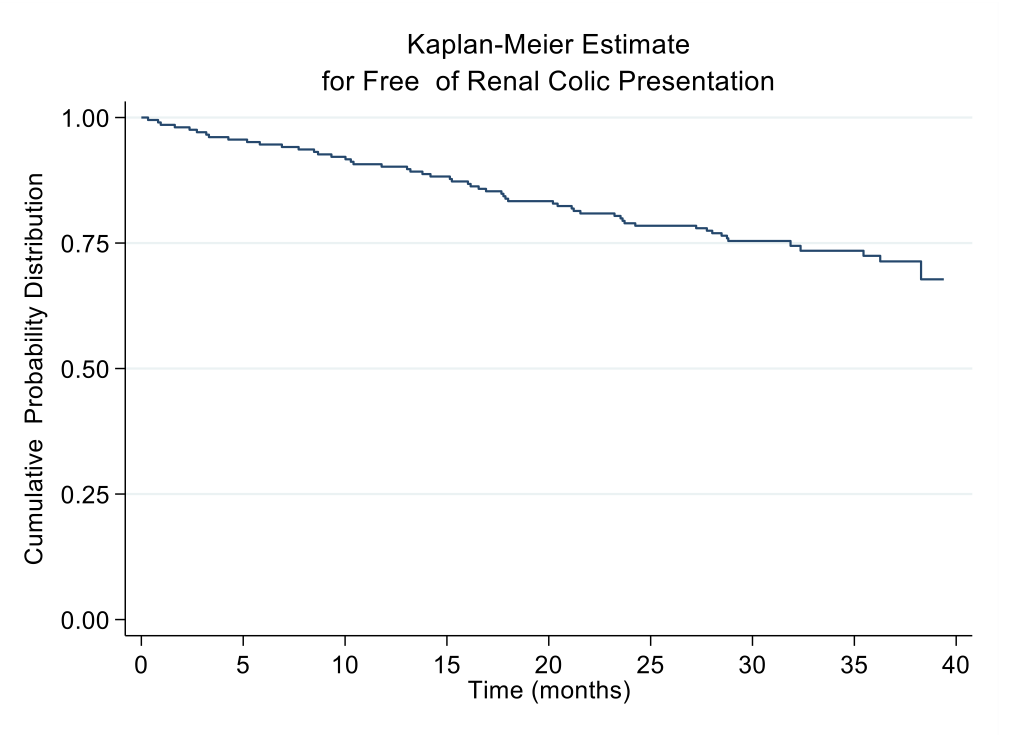Back
Poster, Podium & Video Sessions
Moderated Poster
MP26: Stone Disease: Epidemiology & Evaluation I
MP26-19: The Small Acute Ureteral Stone Protocol: Longitudinal Outcomes
Saturday, May 14, 2022
10:30 AM – 11:45 AM
Location: Room 225
Conrad Bayley*, Tim Wollin, Shubha De, Sentil Senthilselvan, Trevor Schuler, Edmonton, Canada

Conrad James Bayley, BS
University of Alberta Faculty of Medicine and Dentistry
Poster Presenter(s)
Introduction: The small acute ureteral stone (SAUS) protocol was developed in 2018 for patients with ureteral stones <5mm to improve access to urological services. A nurse case manager phones patients to review their symptoms and imaging, and a disposition is determined to the acute stone clinic (ASC), elective stone clinic (ESC), or GP follow up. The clinical outcomes of the protocol were reviewed via a retrospective study in 2019.
This study aims to review the long-term outcomes and provide descriptive analysis of the previously studied SAUS protocol patients. This will elucidate the safety and long-term impact of the protocol on patients’ access to the urology clinics, the impact on repeat emergency department visits, freedom from intervention for the same stone, and ongoing burden on the larger healthcare system.
Methods: A retrospective EMR review of all patients in the previous study was conducted. Data was collected in a REDCap database, with identifiable data stored in a separate encrypted spread sheet to maintain patient confidentiality. A total of 215 records were accessed, 8 excluded due to inaccessible records, and 207 were included.
Results: The 207 patients had a mean age of 49, with a male to female ratio of 2:1.
73.4% (152) of patients had no renal colic presentations in the 2-year period after initial completion of the SAUS protocol. 20.3% (42) of patients returned to ED with renal colic. Of these patients, 21 were referred to urology, 12 opted for conservative management, and 9 had negative imaging in the ED. 6.3% (13) of patients presented to their GP with renal colic. Of these patients, 7 opted for conservative management, 5 had negative imaging, and 1 were referred to urology (for SWL).
Of the 22 urology referrals, 12 of patients had passed their stone(s) by the time they attended their ASC appointment, 8 required ureteroscopy, 1 required PCNL, and 1 required SWL.
94.2% (195) of patients required no urologic interventions.
Conclusions: Initial introduction of the SAUS Protocol to acute ureteral stone management led to a reduction in the need for ASC appointments and interventions for patients with stones <5mm. This is maintained long-term, as the vast majority of SAUS Protocol patients do not re-present or require intervention within 2 years. This study supports the long-term use of the SAUS Protocol as a tool to determine disposition in this population.
Source of Funding: n/a

This study aims to review the long-term outcomes and provide descriptive analysis of the previously studied SAUS protocol patients. This will elucidate the safety and long-term impact of the protocol on patients’ access to the urology clinics, the impact on repeat emergency department visits, freedom from intervention for the same stone, and ongoing burden on the larger healthcare system.
Methods: A retrospective EMR review of all patients in the previous study was conducted. Data was collected in a REDCap database, with identifiable data stored in a separate encrypted spread sheet to maintain patient confidentiality. A total of 215 records were accessed, 8 excluded due to inaccessible records, and 207 were included.
Results: The 207 patients had a mean age of 49, with a male to female ratio of 2:1.
73.4% (152) of patients had no renal colic presentations in the 2-year period after initial completion of the SAUS protocol. 20.3% (42) of patients returned to ED with renal colic. Of these patients, 21 were referred to urology, 12 opted for conservative management, and 9 had negative imaging in the ED. 6.3% (13) of patients presented to their GP with renal colic. Of these patients, 7 opted for conservative management, 5 had negative imaging, and 1 were referred to urology (for SWL).
Of the 22 urology referrals, 12 of patients had passed their stone(s) by the time they attended their ASC appointment, 8 required ureteroscopy, 1 required PCNL, and 1 required SWL.
94.2% (195) of patients required no urologic interventions.
Conclusions: Initial introduction of the SAUS Protocol to acute ureteral stone management led to a reduction in the need for ASC appointments and interventions for patients with stones <5mm. This is maintained long-term, as the vast majority of SAUS Protocol patients do not re-present or require intervention within 2 years. This study supports the long-term use of the SAUS Protocol as a tool to determine disposition in this population.
Source of Funding: n/a


.jpg)
.jpg)